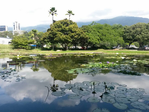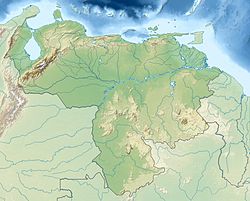| UNESCO World Heritage Site | |
|---|---|
| Location | Libertador Bolivarian Municipality, Capital District, Caracas, Venezuela |
| Criteria | Cultural: (i), (iv) |
| Reference | 986 |
| Inscription | 2000 (24th Session) |
| Area | 164,203 ha (405,750 acres) |
| Coordinates | 10°29′27″N 66°53′26″W / 10.49083°N 66.89056°W |
The University City of Caracas (Spanish: Ciudad Universitaria de Caracas), also known by the acronym CUC, is the main campus of the Central University of Venezuela (UCV), located in central Caracas, the capital of Venezuela. It was designed by the Venezuelan architect Carlos Raúl Villanueva and was declared a World Heritage Site by UNESCO in 2000. The Ciudad Universitaria de Caracas is considered a "masterpiece" of architecture and urban planning,[1] and greatly influenced Venezuelan architecture.[2]
Villanueva oversaw design from the end of the Second World War, and oversaw the campus construction for 20 years. He gave his skills and also vision of design principles to it, and it remains the only university campus designed by a single architect in the 20th century that has received cultural heritage recognition by UNESCO.
The campus comprises a variety of different environments; its northern half is a Botanical Garden, with extensive sports facilities at its east, west and south. There are many different areas of the campus separated by Faculty and School, including Sciences, Architecture, Humanities, and Medicine. These converge in the center of the campus at the Tierra de nadie — green space and woodland pertaining to no discipline — and the Plaza Cubierta complex of shared buildings and the titular museum of permanent modern art features.
Though elements of the campus face both natural and deliberate deterioration, it remains a landmark of Venezuela, and maintains its excellence in design and planning. It has been included on the 2010 and 2014 lists of the World Monuments Fund for special preservation efforts.[3]
- ^ "Ciudad Universitaria de Caracas". UNESCO. Retrieved 28 May 2010.
- ^ Sennott, Stephen (2004). Encyclopedia of 20th century architecture. New York: Fitzroy Dearborn. p. 267. ISBN 1-57958-243-5. OCLC 52688206.
- ^ "Ciudad Universitaria de Caracas". World Monuments Fund. Retrieved 2019-08-19.





